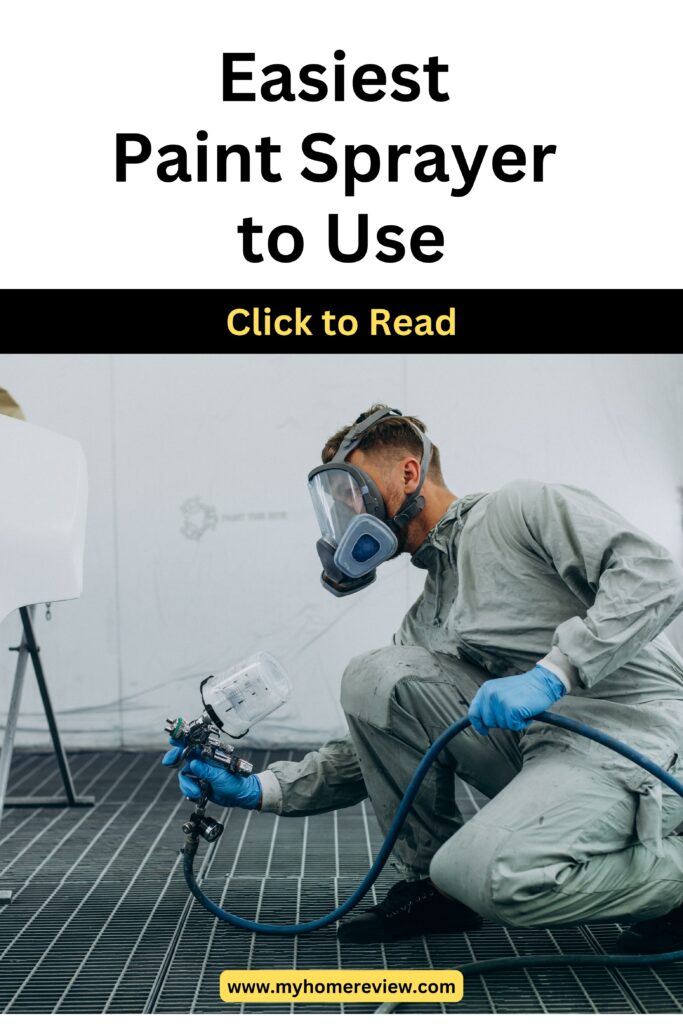This article is to help people to know the easiest paint sprayer to use, especially those who are not familiar with paint sprayers. There are many reasons why looking for an easy-to-use paint sprayer is important.
First, an easy-to-use paint sprayer is more likely to be user-friendly and intuitive in its operation, which may help the painting process run more efficiently and successfully.
This is especially important for people who are new to using paint sprayers because they may not have much experience with the product and would benefit from a clearer and easy-to-understand design.
Furthermore, a simple-to-use paint sprayer is more likely to forgiving of mistakes, as it is less likely to require a particularly exact technique or specific adjustments to achieve the intended result.
People who are new to painting or do not have much experience with paint sprayers will benefit significantly from this, especially if they are just getting started.
Finding an easy-to-use paint sprayer is especially important for people who have never worked with a device of this type before, as it may help to make painting a more enjoyable and productive experience.
First, here is a summary of what we have covered in this post
What to Consider When Choosing A Paint Sprayer?
When choosing a paint sprayer, it is important to consider various factors, including the sprayer’s dimensions and weight, ease of cleaning and maintenance, the type of paint and surface that will be sprayed, and the cost and availability of replacement parts.
When selecting a sprayer, it is important to consider its size and weight because an unwieldy or heavy sprayer may be challenging to operate and cause fatigue when used for extended periods.
On the other hand, a lightweight and compact sprayer may be easier to manage and more pleasant to operate, especially if you need to paint in tight spaces or hard-to-reach areas. This is especially true if you need to paint in small or difficult-to-reach areas.
A sprayer that is difficult to clean or maintain may become inconvenient to use with time; consequently, the ease with which it can be cleaned and maintained is an extra critical factor to consider.
Look for a sprayer that is easy to disassemble and clean and has readily available replacement parts in case something breaks.
Another important factor to consider when shopping for a paint sprayer is the type of paint and the surface that will be sprayed with it. Because different sprayers are designed to work with various paints and surfaces, selecting one appropriate for the materials you will be working with is critical.
Last, the cost and availability of replacement components are important considerations. A more expensive sprayer may have a higher initial purchase price. Still, it may also be more durable and have a more extended warranty or a more comprehensive service plan.
On the other hand, a cheaper sprayer may be less expensive at first, but it will be less durable and have a shorter lifetime, which means it will need to be serviced or replaced more frequently.
Top Contenders for The Easiest Paint Sprayer to Use
There are several leading candidates for the paint sprayer that is the easiest to operate, and each one has its own capabilities and unique features. The following is a summary of some of the top contenders, with a discussion of their key features and pros and cons:
• Magnum 262800 X5 Stand Airless Paint Sprayer: This sprayer is designed for professional use and can be used on various paints and coatings. It has a stainless steel piston pump with a spraying capacity of up to 0.27 gallons per minute.
In addition, it is constructed from a lightweight material and includes a convenient trolley for easy transport.
Pros: Capable of handling a wide range of paints and coatings and being durable and effective.
Cons: The price may be higher than other available options.
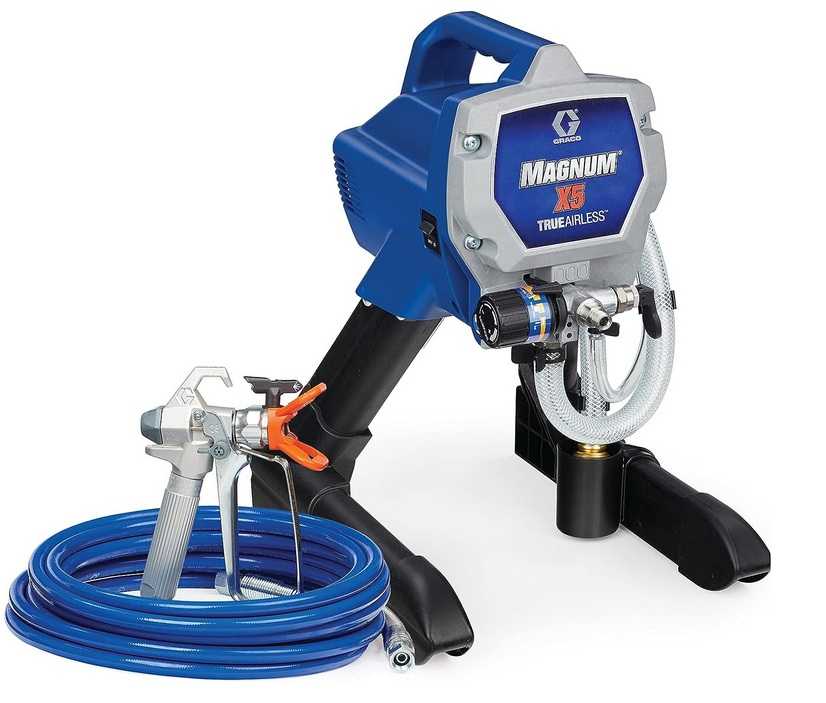
• Wagner Flexio 590 HVLP Paint Sprayer: This sprayer can be used on various surfaces, including walls, ceilings, and furniture. It is intended for use with low pressure and high volume.
It has an HVLP (High Volume, Low Pressure) design, which enables better control and precision. It also has an adjustable spray pattern. Additionally, its design makes it easy to transport.
Pros: The adjustable spray pattern provides greater precision and control, and the product is lightweight and transportable.
Cons: Possible incompatibility with extremely thick paints or coatings.
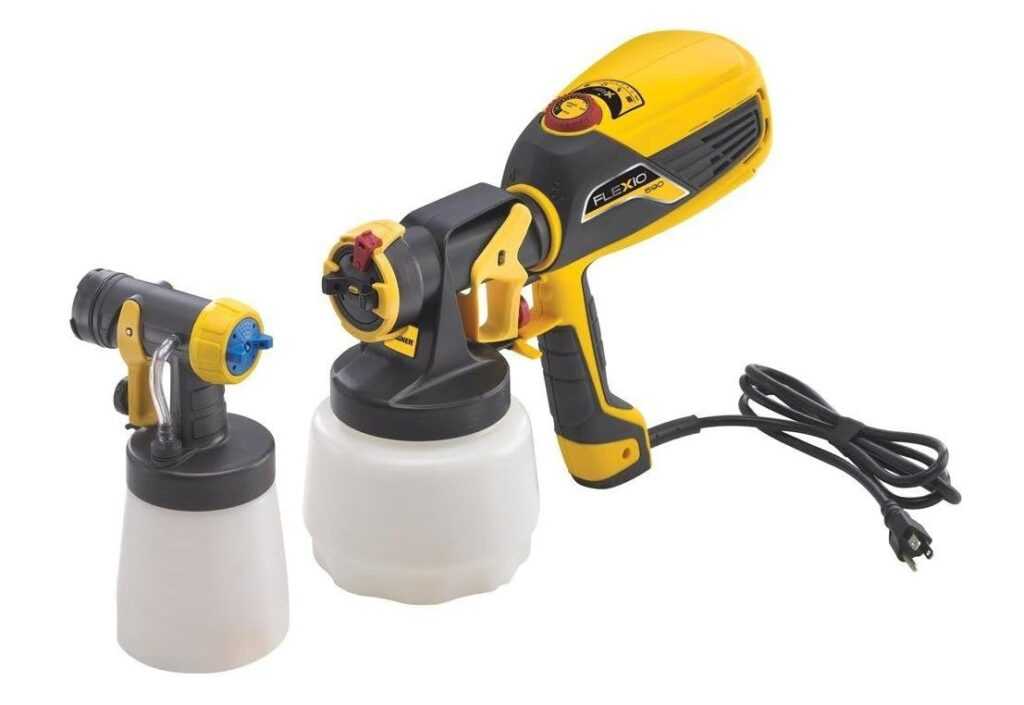
• HomeRight C800971. A Super Finish Max Extra Power Painter: This sprayer is designed to be used on various surfaces, including walls, furniture, and cabinets.
It has a powerful motor and a huge paint cup, allowing you to spray paint swiftly and efficiently. In addition, it is designed for the comfort of use due to its lightweight and ergonomic design.
Pros: Among the benefits are a paint cup with a high capacity, a powerful motor that enables effective spraying, and a lightweight and ergonomic design.
Cons: Possible incompatibility with extremely thick paints or coatings.
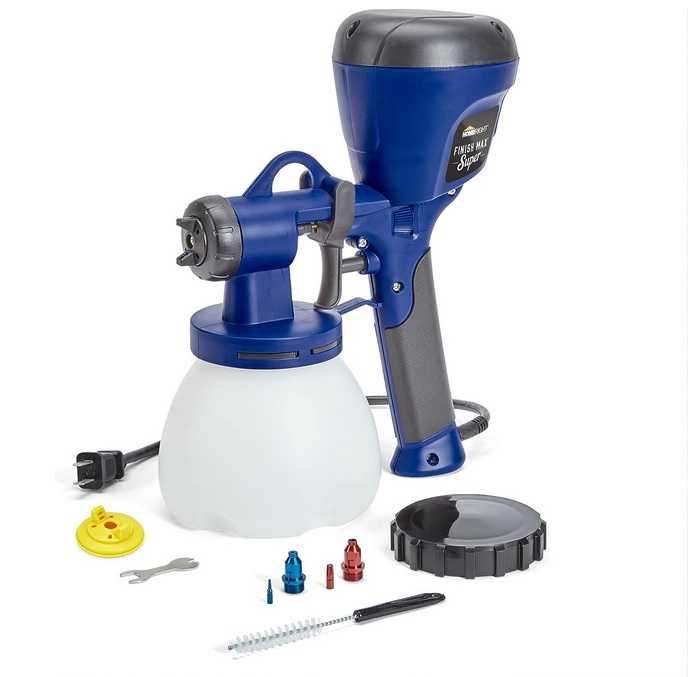
• REXBETI Ultimate-750 Paint Sprayer: Because of its design this sprayer can be used on various surfaces, including walls, furniture, and cabinets.
It contains a paint cup with a high capacity and three adjustable spray patterns, allowing for greater control and precision. In addition, it is comfortable to use because of its lightweight and ergonomic design.
Pros: A paint cup with a high capacity, three adjustable spray patterns for better control and accuracy, and a lightweight and ergonomic design.
Cons: Possible incompatibility with extremely thick paints or coatings.
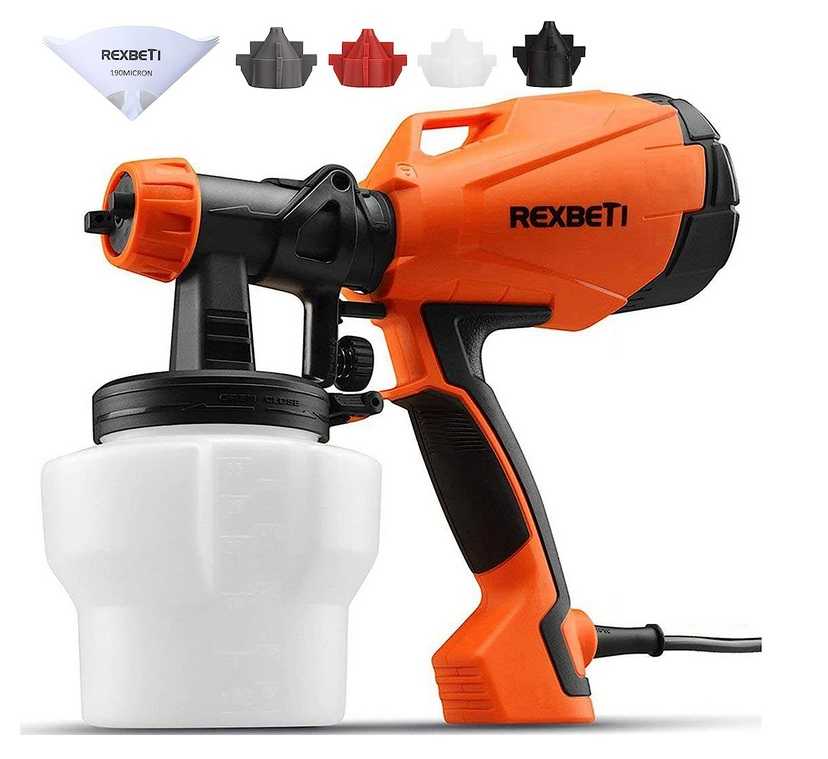
Ultimately, the type of paint sprayer that will work best for you will be determined by your precise needs and tastes.
Consider the sprayer’s size and weight, ease of cleaning and maintenance, the type of paint and surface to spray, and the cost and availability of replacement parts before choosing.
Conclusion
Your painting experience will be improved if you find a paint sprayer that is easy to use, resulting in a more productive and fun experience. Various factors must be considered when choosing a paint sprayer.
These factors include the size and weight of the sprayer, the ease with which it may be cleaned and maintained, the type of paint and surface that will be sprayed, and the cost and availability of replacement parts.
The Graco Magnum 262800 X5 Stand Airless Paint Sprayer, in our opinion, is the best paint sprayer on the market today. It is our recommendation based on the criteria discussed in this blog post. This sprayer is for commercial use and can work with various paints and coatings.
It features a stainless steel piston pump capable of spraying up to 0.27 gallons per minute. Furthermore, it has a compact, lightweight design and a convenient cart that makes transportation easy.
However, remember that your demands and tastes will be the deciding factors in selecting the paint sprayer that will perform best for you. We advise our readers to research and choose the sprayer that best meets their needs.
When deciding, consider the sprayer’s size and weight, ease of cleaning and maintenance, the paint and surface that will be sprayed, and the cost and availability of replacement parts.
If you have the correct paint sprayer, you will get results that rival a professional’s and also complete your painting chores quickly.
Related Post:
- Air or Airless Paint Sprayer; Which One Is A Better Choice?
- Which Type of Paint Sprayer Is Most Suitable for Wall Applications?
What Should I Consider When Looking for The Easiest Paint Sprayer to Use?
There are a few important factors to consider while looking for an easy-to-use paint sprayer, including the following:
• Ease of setup: When looking for a paint sprayer, look for one that is easy to assemble and disassemble, with simple instructions and as few components as possible. As a result, preparing the sprayer for use and cleaning it afterwards will be much easier.
• Ease of control: The best paint sprayers will have controls that are simple and easy to use. Look for features that will make achieving the desired finish much easier, such as variable speed or pressure control and changing spray patterns.
Consider the paint sprayer’s weight, size, and portability and how easy it is to carry it from one location to another. A lightweight and tiny design will be more convenient if you intend to use the sprayer in different areas or locations.
• Ease of cleaning: Paint sprayers that are simple to use will also be simple to clean after use. Look for features that will make cleaning easier and more efficient, such as a removable nozzle and a cleaning brush.
• Cost: A easy-to-use paint sprayer does not have to be the most expensive; consequently, it is necessary to consider the total cost of the sprayer and its functions. There’s a chance that simpler devices that are also user-friendly will be less expensive.
It is also important to remember that some paint sprayers, such as those designed for oil-based or water-based paints, are only designed to function with those paints.
Check the manufacturer’s requirements to ensure that the paint sprayer you buy is compatible with the type of paint you intend to use.
Is It Worth It to Invest in A More Expensive Paint Sprayer?
Before determining whether or not to buy an expensive paint sprayer. There are some factors to consider. One of the key advantages of purchasing one of these sprayers is that it may have more advanced features and capabilities.
These features may include greater accuracy and control over the flow of paint and a more powerful motor capable of handling thicker or heavier paint.
Paint sprayers that cost more money may also be built with higher-quality materials, resulting in a longer lifespan and greater resistance to wear and tear.
Buying a more expensive paint sprayer is an option, but it has a few potential negatives that should be addressed. One of the most significant disadvantages is that the price may be substantially higher than that of a more reasonably priced model.
If you are not an experienced painter, getting a more expensive paint sprayer may be a disadvantage because it may be more challenging to use.
When deciding if spending more money on a paint sprayer is beneficial, your specific requirements and financial limits are the two most important factors to consider.
If you have a large painting project that requires a high level of accuracy and control, or if you want to use your paint sprayer frequently, it may be advantageous to invest in a more expensive model.
On the other hand, if you are working on a much smaller project or have a limited budget, a less expensive paint sprayer may be a better choice for you.
Can I Use Any Type of Paint with A Paint Sprayer?
When choosing a paint sprayer, it is important to consider the type of paint used. There are different types of paint, and only a handful of them may be efficiently sprayed with a paint sprayer.
Oil-based paints, for example, are not recommended for use with paint sprayers since they have the potential to clog the nozzle and make cleaning the equipment more difficult.
On the other hand, paint sprayers are most commonly used with water-based or latex paints since these paints are easy to clean and do not clog the nozzle as easily as oil-based paints.
You should also consider the thickness of the paint. If the paint is excessively thick, the sprayer’s nozzle may become blocked, resulting in the sprayer not working properly.
It is possible to increase the flow of paint through the nozzle of a paint sprayer by thinning the paint first with water or a thinner designed specifically for use with paint sprayers.
Last but not least, before using your paint sprayer, carefully read the manufacturer’s instructions to determine which types of paint are compatible with it.
How Do I Clean and Maintain My Paint Sprayer?
To guarantee that a paint sprayer continues to operate properly and may be used for other applications in the future, it must be thoroughly cleaned and maintained. Here are a few things to remember when it comes to maintaining and cleaning your paint sprayer:
• Use water or a cleaning solution to flush the sprayer: It is important to flush the sprayer with water or a cleaning solution after each use to remove any leftover paint. As a result of this measure, the sprayer will be less prone to blockage.
• Disassemble the sprayer: You may need to disassemble the sprayer to clean some components. This will be determined by the type of sprayer you have. It may be necessary to disassemble the spray tip, nozzle, and other components to ensure that they are clean and free of paint.
• Check that the filters are clean: Filters are an important part of paint sprayers because they remove pollutants from the paint. Any of these filters should be cleaned or changed as needed.
• Lubricant should be applied to moving parts: Some paint sprayers have moving parts that must be lubricated to function properly. Always read the manufacturer’s instructions on which components should be greased and what type of lubricant should be used.
• Make sure the sprayer is stored correctly: You should keep the paint sprayer in a dry and clean place when not in use. Cover the sprayer to prevent dirt and debris from entering.
It is also worth noting that some paint sprayers have a guidebook with detailed instructions on cleaning and maintaining the paint sprayer. This is something that should be taken into account. You are strongly encouraged to refer to the manual of your paint sprayer for specific instructions.
Can I Use A Paint Sprayer for Both Indoor and Outdoor Projects?
A paint sprayer can be used for projects that are done both indoors and outdoors. However, it is critical to consider the paint sprayer’s specific features and assess whether or not it is suitable for both types of projects.
For example, an airless paint sprayer is a powerful tool that can handle heavier paints. As a result, it is appropriate for use in outdoor projects such as painting exterior walls or decks. However, it may not be the best choice for interior work because it generates high pressure and overspray.
HVLP (High Volume, Low Pressure) and LVLP (Low Volume, Low Pressure) paint sprayers are meant to produce less overspray. They are better suited for indoor operations such as painting a room or furniture.
You must carefully evaluate the paint you intend to use for your project, as different types of paint require different sprayers.
Before selecting whether or not to use the paint sprayer for both indoor and outdoor tasks, evaluate the paint sprayer’s features and capabilities, as well as the type of project, you will be using it for, to determine whether or not it can be used for both indoors and outdoors projects.
Recommended Post: Reviews of the Top Paint Sprayers for Furniture
